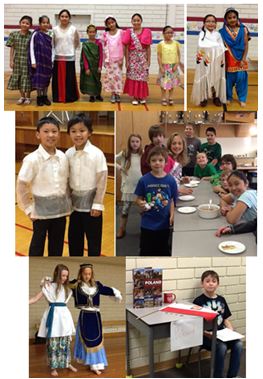This past Friday our school held its first ‘Cultural Fair’. It all started with my Leadership class, which is one of the option classes my school is piloting this year. We started by talking about qualities of a leader, while looking at models like Terry Fox. Then we learned about different types of leadership projects; action, awareness and fundraising. After a few weeks of exploring how projects should be planned and structured, the students decided to take on organizing a cultural fair.
What was the end result? Out of our 230 student body, 50 students participated. We had a variety of events throughout the day, including country presentations, food sharing and performances. The confidence and enthusiasm demonstrated by students was amazing! We had 10 proud students sing us the Pilipino National Anthem., and then a grade 2 student serenade the school in Spanish (making all heart melt). Many dances were performed from several different cultures, all of them wonderful. Even a few grandparents showed up to support their grandchildren in teaching about their cultures. Throughout the day we also invited students to wear their cultural dress and to bring food to share with their class. So many wonderful dishes were shared - butter chicken, poutine, Pilipino noodles, samosas, borsch, perogies, dulce de leche, plum cake, double buns.
Looking back at our day, here are some of the outcomes I believed we touched upon:
1) Students demonstrated pride for their cultural heritage
2) Students appreciated various cultural practices, languages and countries
3) Students demonstrated confidence in expressing information in various forms (dance, presentations, food sharing)
I strongly encourage your school to give it a try! If you are interested in putting on a school cultural fair, here is a resource that may give you a place to start:
http://www.nwt.literacy.ca/resources/famlit/howtokit/culture_days_activities.pdf
Jessica Marcotte
@jmarcotte85
What was the end result? Out of our 230 student body, 50 students participated. We had a variety of events throughout the day, including country presentations, food sharing and performances. The confidence and enthusiasm demonstrated by students was amazing! We had 10 proud students sing us the Pilipino National Anthem., and then a grade 2 student serenade the school in Spanish (making all heart melt). Many dances were performed from several different cultures, all of them wonderful. Even a few grandparents showed up to support their grandchildren in teaching about their cultures. Throughout the day we also invited students to wear their cultural dress and to bring food to share with their class. So many wonderful dishes were shared - butter chicken, poutine, Pilipino noodles, samosas, borsch, perogies, dulce de leche, plum cake, double buns.
Looking back at our day, here are some of the outcomes I believed we touched upon:
1) Students demonstrated pride for their cultural heritage
2) Students appreciated various cultural practices, languages and countries
3) Students demonstrated confidence in expressing information in various forms (dance, presentations, food sharing)
I strongly encourage your school to give it a try! If you are interested in putting on a school cultural fair, here is a resource that may give you a place to start:
http://www.nwt.literacy.ca/resources/famlit/howtokit/culture_days_activities.pdf
Jessica Marcotte
@jmarcotte85

 RSS Feed
RSS Feed
